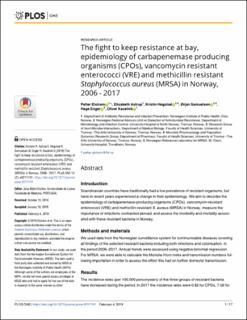| dc.contributor.author | Elstrøm, Petter | |
| dc.contributor.author | Astrup, Elisabeth | |
| dc.contributor.author | Hegstad, Kristin | |
| dc.contributor.author | Samuelsen, Ørjan | |
| dc.contributor.author | Enger, Hege | |
| dc.contributor.author | Kacelnik, Oliver | |
| dc.date.accessioned | 2021-02-17T13:24:27Z | |
| dc.date.available | 2021-02-17T13:24:27Z | |
| dc.date.created | 2019-04-05T15:52:15Z | |
| dc.date.issued | 2019 | |
| dc.identifier.citation | PLoS ONE. 2019, 14:e0211741 (2), 1-17. | en_US |
| dc.identifier.issn | 1932-6203 | |
| dc.identifier.uri | https://hdl.handle.net/11250/2728704 | |
| dc.description.abstract | Introduction: Scandinavian countries have traditionally had a low prevalence of resistant organisms, but have in recent years experienced a change in their epidemiology. We aim to describe the epidemiology of carbapenemase-producing organisms (CPOs), vancomycin-resistant enterococci (VRE) and methicillin-resistant S. aureus (MRSA) in Norway, measure the importance of infections contracted abroad, and assess the morbidity and mortality associated with these resistant bacteria in Norway.
Methods and materials: We used data from the Norwegian surveillance system for communicable diseases covering all findings of the selected resistant bacteria including both infections and colonisation, in the period 2006–2017. Annual trends were assessed using negative binomial regression. For MRSA, we were able to calculate the Morisita-Horn index and transmission numbers following importation in order to assess the effect this had on further domestic transmission.
Results: The incidence rates (per 100,000 personyears) of the three groups of resistant bacteria have increased during the period. In 2017 the incidence rates were 0.82 for CPOs, 7.09 for VRE and 43.8 for MRSA. 81% of CPO cases were diagnosed in hospitals, but 73% were infected abroad. Most VRE cases were infected in Norwegian hospitals, 85% were associated with hospitals outbreaks. MRSA was predominantly diagnosed in the community, only 21% were diagnosed in hospitals. Of all MRSA cases, 35% were infected in other countries. Most MRSA spa-types were not identified again after introduction, resulting in a transmission of MRSA equivalent to a mean of 0.30 persons infected from each spa-type identified (range: 0–22). The proportion of infections among all notified cases within each diagnose was 44% for MRSA, 9% for VRE and 45% for CPOs. Among persons notified with bacteraemia, the 30 days all-cause mortality were 20%, 16% and 50% for MRSA, VRE and CPOs respectively.
Discussion: The incidence rates of CPOs, VRE and MRSA in Norway are low, but increasing. The continuing increase of notified resistant bacteria highlights the need for a revision of existing infection prevention and control guidelines. | en_US |
| dc.language.iso | eng | en_US |
| dc.publisher | PLOS | en_US |
| dc.rights | Navngivelse 4.0 Internasjonal | * |
| dc.rights.uri | http://creativecommons.org/licenses/by/4.0/deed.no | * |
| dc.title | The fight to keep resistance at bay, epidemiology of carbapenemase producing organisms (CPOs), vancomycin resistant enterococci (VRE) and methicillin resistant Staphylococcus aureus (MRSA) in Norway, 2006-2017 | en_US |
| dc.type | Peer reviewed | en_US |
| dc.type | Journal article | en_US |
| dc.description.version | publishedVersion | en_US |
| dc.source.pagenumber | 1-17 | en_US |
| dc.source.volume | 14:e0211741 | en_US |
| dc.source.journal | PLoS ONE | en_US |
| dc.source.issue | 2 | en_US |
| dc.identifier.doi | 10.1371/journal.pone.0211741 | |
| dc.identifier.cristin | 1690517 | |
| dc.description.localcode | © 2019 Elstrøm et al. This is an open access article distributed under the terms of the Creative Commons Attribution License, which permits unrestricted use, distribution, and reproduction in any medium, provided the original author and source are credited. | en_US |
| cristin.unitcode | 1920,14,0,0 | |
| cristin.unitname | Laboratoriemedisinsk klinikk | |
| cristin.ispublished | true | |
| cristin.fulltext | original | |
| cristin.qualitycode | 1 | |

